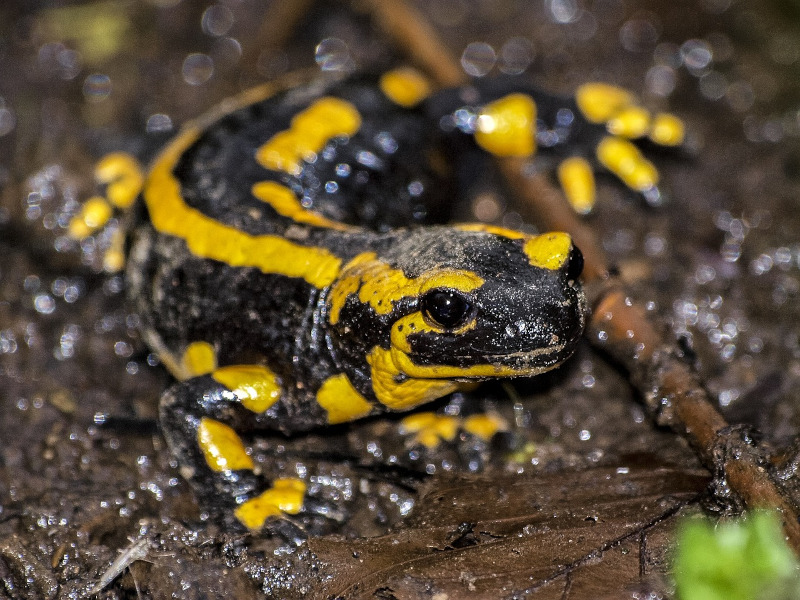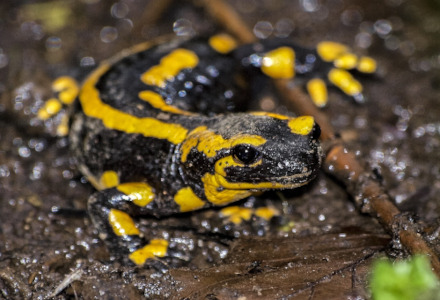
Fire Salamander Facts
- This remarkable product of Nature and evolution is most frequently known by the attention-grabbing common name of Fire Salamander. For the moment, it has no other widely accepted general title. But with the one it has, it really doesn’t need others.
- Within scientific circles, however, it’s usually better known by its technical title. That’s a distinctive one, though. It’s also relatively simple for the layperson to pronounce. That’s because the amphibian bears the official moniker of the Salamandra salamandra.
- It received that almost poetic name due to the efforts of Carl Linnaeus. The highly esteemed Swedish zoologist accomplished the first formal recognition of the animal as a separate and distinct species. That scientifically noteworthy deed occurred in 1758.
- It’s a fascinating creature for many reasons. Among these remains the fact that multiple subspecies of the animal exist. Currently, researchers acknowledge a total of 13 of these. Many of those also share the same habitat range, often creating much confusion.
- Fortunately, the Fire Salamander seems to be maintaining a population base that’s both stable and sufficient. That pleasant condition further appears to hold true throughout the entirety of its range. The IUCN therefore now lists the animal as Least Concern.
- The salamander still faces several potential threats to its existence, at least. Many of these stem from the actions of humans. They include such perils as habitat degradation and loss due to human expansion. It also naturally faces the threat of climate change.
Related Articles
Fire Salamander Physical Description
The intriguing Fire Salamander generally captivates those fortunate enough to encounter it. The creature typically does so, however, due more to its appearance than sheer physical size. That’s true since, in that particular respect, it ranks as about average among its kin.
It does follow a pattern common in its relatives, though. That’s in the fact that it displays a certain degree of the physiological characteristic of sexual dimorphism. In the case of this amphibian, that trait manifests itself in terms of both appearance and physical structure.
Individuals of the amazing species attain an overall average length of body and tail for an amphibian. This measurement equates to between 9.8 – 11.8 in (25 – 30 cm) in adults. Typically, however, females reach a slightly greater length than their male counterparts do.
The tail usually develops as somewhat cylindrical in shape, and a little shorter than the body. The legs also develop as comparatively short. In yet another example of gender-based physical differences, both the tail and legs of the female generally remain shorter than males.
Yet it’s the color pattern of the dazzling Fire Salamander that most often garners the most attention. The back and sides present a background of a deep black color. That’s contrasted strongly by the presence of spots and or bands. These show as either a yellow or orange hue.
The underside presents a somewhat different pattern of coloring. This part of the body of the animal generally presents either a dark brown or black shade. Most examples do not have the spots or bands here, but variations and exceptional specimens do naturally occur.
- Kingdom: Animalia
- Phylum: Chordata
- Class: Amphibia
- Order: Urodela
- Family: Salamandridae
- Genus: Salamandra
- Species: S. salamandra
Fire Salamander Distribution, Habitat, and Ecology
The Fire Salamander evolved as native to a moderately wide expanse of the globe. This serves as a source of occasional confusion, hower. That’s because many of its subspecies appear nearly identical, and they live in other parts of the world, as well as its own range.
This species itself, though, only appears in what’s now known as Europe. There, it primarily lives in the southern and central portions of the continent. That ranges from Spain and Portugal in the southwest to Poland in the north, and to Italy and Greece in the south.
The animal also evolved decidedly strong preferences for its choice of habitat. This principally consists of forested regions. Even there, though, the amphibian displays a preference. Within these forested areas, it most often shows itself in areas of significant hills.
It does seem to prefer deciduous forests, however. In these regions, the fauna frequently conceals itself on or near mossy tree trunks or amid clumps of fallen leaves. It additionally requires the nearby presence of small streams or ponds with an abundance of clean water.
The Fire Salamander is mainly active in the evening and at night. It also comes out during the day when it’s raining, though. When not actively hunting or fleeing predators, it spends the vast majority of its time hiding under various available objects for its own protection.
It also developed as a carnivorous species, like most of its relatives. Much of its prey consists of such smaller creatures as spiders, various insects, centipedes, millipedes, earthworms, and slugs. It sometimes varies this with the addition of newts and young frogs.
Its own predators remain few and far between, however. That’s due to the fact that it’s moderately toxic. Few animals therefore feed on it, though a few are immune to or tolerant of this. Its main threats come from grass snakes, hawks, eagles, and larger reptiles.
Species Sharing Its Range
Check oout our other articles on 4 Phenomenal Philippine’s Reptiles, Wilson’s Bird-of-paradise, Yosemite Valley, Southern Plains Bumblebee, Desert Willow, Golden Jackal

